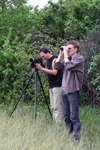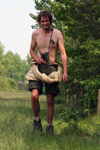 Moerdijk Field Research 2005-2006
Moerdijk Field Research 2005-2006
(last update: 14 August 2010)
Roland-Jan Buijs
Theo Muusse
Mars Muusse
Introduction
Methods
Age, origin & sex
Retrapped Birds
Upperparts Greytone
Black on Primary Coverts
Black on Primaries
P10 and P9 Patterns
P5 Pattern
Red & Black on Bill
Iris & Orbital Ring
Primary Moult
Discussion
References
Phenotypic characteristics and moult commencement in breeding Dutch Herring Gulls Larus argentatus & Lesser Black-Backed Gulls Larus fuscus
- M. Muusse, T. Muusse, R-J. Buijs, R. Altenburg, C. Gibbins & B-J. Luijendijk -
Introduction
Birds with a large geographic distribution commonly show variation in plumage throughout their range. This plumage variation is often the basis for describing different subspecies. In the western Palaearctic, the argentatus-fuscus-complex has raised many debates over the classification of species and subspecies. Based on recent molecular work, the most distinct populations are nowadays classified full species, as described in Yesou (2002).
But how do we identify individual birds in the field? With full species status for closely related taxa, the interest for the variation within a population has increased. In this paper, we describe two Dutch subspecies: Herring Gull Larus argentatus argenteus and Lesser Black-backed Gull L. fuscus graellsii. For both these taxa we describe their intra-population variation.
Several publications deal with phenotypic characteristics and moult commencement in Herring and Lesser Black-backed Gulls. Voous (1959) compared Herring Gulls from four locations in Europe to measure mantle colour, size and wing pattern. The very thorough work by Goethe (1961) deals with wingtip patterns and head dimensions of 160 Herring Gulls from the island Mellum in Germany. Stresemann & Stresemann (1966) describe the moult timing after examining museum specimen. Harris (1971). Barth’s work (1968, 1975) covered populations of both species from 13 locations in Europe. He described upper-part grey tone, primary patterns and colour of soft parts. Verbeek (1977) reconstructed primary moult timing from dead birds for both species on Walney Island. Hario (1984) described the moult onset for Herring and Lesser Black-backed Gulls by collecting shed feathers in a Finnish colony. Mierauskas et al (1991) compared yellow-legged Herring Gulls from the eastern Baltic with Caspian Gulls from the S Ukraine on wingtip pattern, vocals and bill dimensions. Stewart (2006) published on moult timing in trapped birds in the Severn Estuary. Buzun (2002) described primary patterns, wing length, iris colour, orbital ring colour and primary moult for West Siberian Gulls.
Continental European Herring Gull L. a. argenteus and Lesser Black-backed Gull L. f. graellsii are known to show phenotypic characteristics which are intermediate between their British (L. a. argenteus & L. f. graellsii) and Scandinavian relatives (L. a. argentatus & L. f. intermedius). However, nothing has been published to date on the moult pattern and detailed phenotype of birds breeding in the Netherlands.
The industrial complex Moerdijk in the Netherlands holds a mixed colony of Herring and Lesser Black-backed Gulls. Colonisation of Moerdijk started in the early 1980s. By 2006, an estimated 650 pairs of Herring Gulls and 2900 pairs of Lesser Black-backed Gulls bred in the colony. In 2005, 157 breeding Herring Gulls and 434 Lesser Black-backed Gulls were colour ringed at Moerdijk, with 158 and 604, respectively, ringed in 2006.
In this paper we use these data collected at Moerdijk to describe the phenotypic characteristics and commencement of primary moult. Seventeen Herring Gulls and 37 Lesser Black-baked Gulls were trapped both in 2005 and 2006. For these birds, only data for 2006 was used. In some chapters we discuss these re-trapped birds to see if scores and patterns changed between the two years.
Our data illustrate the large intra-population variability that exists for these taxa, even within a single colony. We discuss the implications of this variability for field identification of the various sub-species of Herring and Lesser Black-backed Gulls.
Read further on METHODS >
 Industrial complex Shell Moerdijk, research area.
Industrial complex Shell Moerdijk, research area. Roland-Jan Buijs & Job ter Horn.
Roland-Jan Buijs & Job ter Horn. Complete nest: 3 eggs. Good nest to put a cage on.
Complete nest: 3 eggs. Good nest to put a cage on.  Roland-Jan Buijs.
Roland-Jan Buijs. Air view of Shell Moerdijk.
Air view of Shell Moerdijk. Administration in the field.
Administration in the field. Roland-Jan Buijs & Theo Muusse. For some areas, safety equipement required.
Roland-Jan Buijs & Theo Muusse. For some areas, safety equipement required. Job ten Horn.
Job ten Horn. Students of the Agrigultural School going field research.
Students of the Agrigultural School going field research. Attempt to escape.
Attempt to escape. Mars Muusse & Roland-Jan Buijs. Scanning the colony for metal-ringed birds and interesting nests to put cages on.
Mars Muusse & Roland-Jan Buijs. Scanning the colony for metal-ringed birds and interesting nests to put cages on. Cage is placed.
Cage is placed. Mars Muusse explaining the measurements to students.
Mars Muusse explaining the measurements to students. Out in the field...
Out in the field... And back.
And back. Roland-Jan Buijs explaining the measurements to students.
Roland-Jan Buijs explaining the measurements to students. Breeding birds alarming when we enter the colony to place the cages again.
Breeding birds alarming when we enter the colony to place the cages again. Spinder waste dump. Feeding dump in the vicinity of the colony.
Spinder waste dump. Feeding dump in the vicinity of the colony. Roland-Jan Buijs.
Roland-Jan Buijs. After breeding birds disperse. Here, Mars Muusse at Le Portel, France. Crate of salmon left-overs to read rings.
After breeding birds disperse. Here, Mars Muusse at Le Portel, France. Crate of salmon left-overs to read rings.  Fishing trawlers in the S Northsea are important feeding possibilties after the breeding saeson.
Fishing trawlers in the S Northsea are important feeding possibilties after the breeding saeson. Fishing trawlers enter the harbour. Birds take a rest at the sea-dike of Westkapelle, Holland.
Fishing trawlers enter the harbour. Birds take a rest at the sea-dike of Westkapelle, Holland.